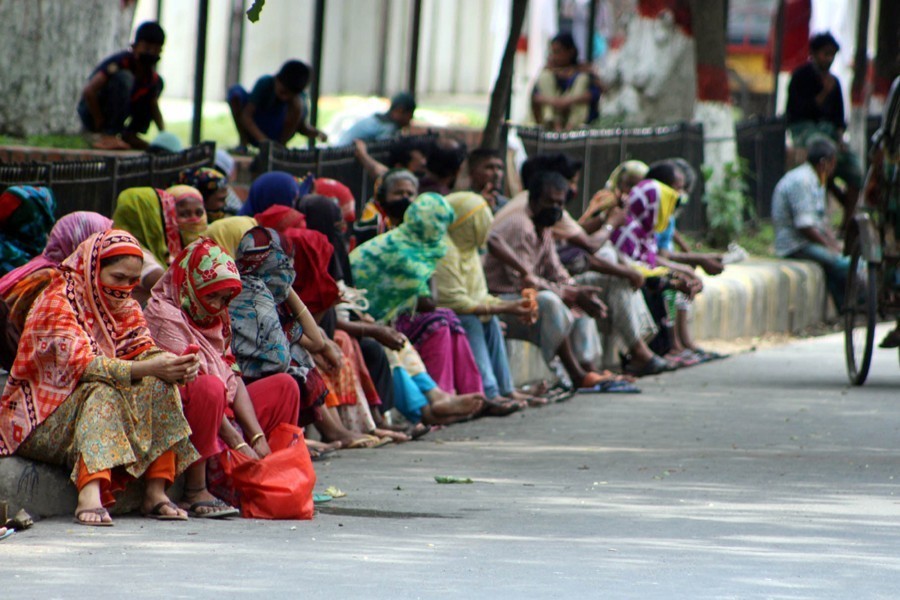
Published :
Updated :

That global shocks cause poverty is well known and few shocks have been as extensive as Covid. What made this pandemic so vicious was that the impact was all encompassing and affected every aspect of life and in every land. Unlike natural disasters which affect a country or a region, Covid was global, making life extremely difficult even for the developed world.
While Covid has been perceived in general as a health crisis, the implications have been in every sector and most in the economic space. It's not just about poverty reduction which is a global goal but ensuring the poor doesn't become even poorer.
The policy objectives are therefore two: to sustain existing levels of poverty reduction and also continue to reduce poverty. That however has not been possible as data states. Plus the emergence of the "new poor" or the "corona poor" has posed new challenges.
In processing these challenges particularly in understanding management of "new poverty "generated by Covid, lessons have been learnt and some applied. While the formal sector players have been involved in the longer term strategy, several new ones have been tried.
These don't fall outside the matrix of general poverty alleviation programmes. What makes it a lesson teacher is that in 2021 new innovations have emerged from both the formal and the informal sectors based on past experiences.
The World Bank (WB) had stated that global poverty would decrease by about 21 million people compared with 2020 rates of decline. WB has been positive with this rate. It states in a report in 2022, "This represents exactly the same decline we had expected would occur in 2021 before the pandemic hit. The implications of this estimate are that global poverty is projected to decline, and the pace of reduction is returning to the pre-pandemic trend. In that sense, one could say that global poverty may be turning the corner on the pandemic in 2021. "
COVID-induced poverty has been high and some say around 100 million people were affected. Given the current standard rate of poverty reduction, and if that is added to the pandemic poverty, millions of people will continue to live in poverty in Bangladesh and the world. What that means is that specific corona inducted or affected people have to be targeted to lift them out of a shock poverty syndrome situation.
In Bangladesh one of the examples of such targeted interventions has been the "incentive "scheme which was supposed to reach a large number of people. Though well intentioned, it has been not as successful as hoped for with the usual complaints of misuse and inefficient implementation. The middle class and those hovering around such plans may have had better access to it than the lower middle class and the poor.
This doesn't have much to do with the intent of the sponsors but the capacity to implement large scale projects while handling transparency in transaction and efficiency at the same time.
The basic problem as always is the lack of conversation between the formal and the informal and the flexibility needed to respond to new challenges. This is apart from the structural issues that arise in emergency interventions including corruption which is a major system blocker.
This was also noted in the management of the Covid itself where the formal health system was under great pressure but the informal segments also responded with their own social mechanisms whether in urban slums or in the rural areas. The capacity of the informal was therefore significantly robust even at the worst of times. The intermediary agencies are also able to conduct transactions with multiple sectors that stand to add more resources to the people facing disasters, whether in the health or the economic domain.
That a conversation between the formal and the informal is required is recognized by many. The kind of "demonization" of all agencies that don't carry the official seal is less now as track records of all informal agencies have been established. The dynamics of poverty reduction initiative has created a new conceptual space.
Development specialist Naseer Jamadar writes, " Much of the debate between the government and NGO collaborations is concerned with the regulatory powers of the state. The fundamental issue relates to the rights of NGOs to pursue their objectives. In Bangladesh, government and NGOs collaboration has been working very well, based on their past experiences in development strategies. ( Economic Recovery after the COVID-19 and Poverty Reduction in Bangladesh. Naseer Jamadar)
One of the NGOs -BRAC- who used their previous experiences in poverty reduction initiatives to tackle the "covid poor" issue yielded largely positive results. The two major lessons were summed up as follows in their report.
One, The programme focused on both capital and care to help revive the new poor's livelihood. Data showed that care is as important as capital provisions in managing a post-crisis situation.
Two, timing was very important. It meant that to be effective any intervention had to be quick and timely so that the capacity of the household to bounce back after a disaster was not so compromised that it couldn't utilize the capital and care provided by any agency.
In summary, the lesson is that disasters are part of collective life and large shocks like Covid can affect major vulnerable social segments' capacity to cope with life and livelihood. The response mechanism has to be based on tried methods and a network of delivery systems based on society's organic capacity can be used to exit a grim situation. That requires a series of convergent activities that can be provided only when the formal and the informal sector work together.
afsan.c@gmail.com


 For all latest news, follow The Financial Express Google News channel.
For all latest news, follow The Financial Express Google News channel.